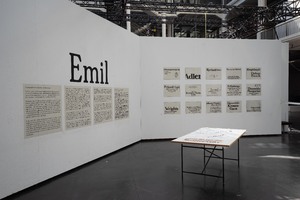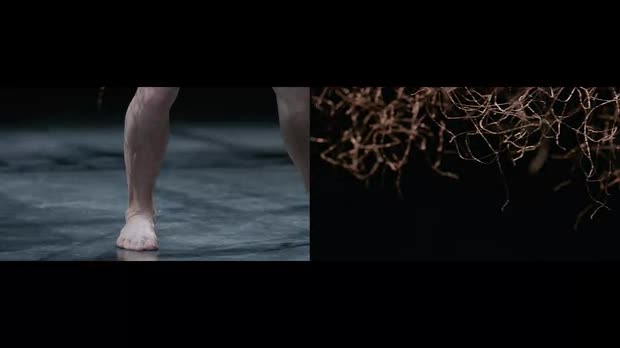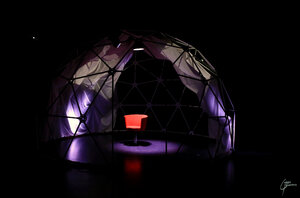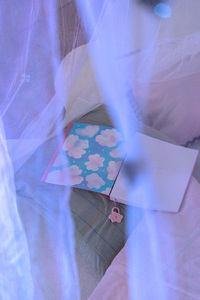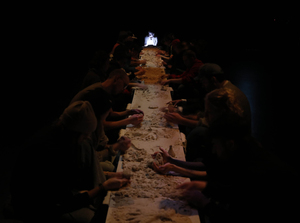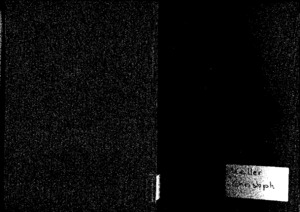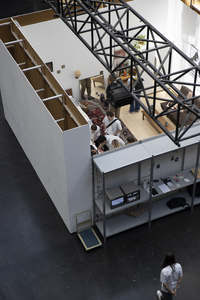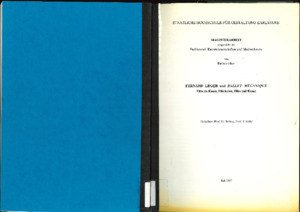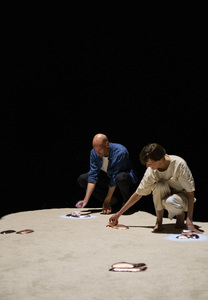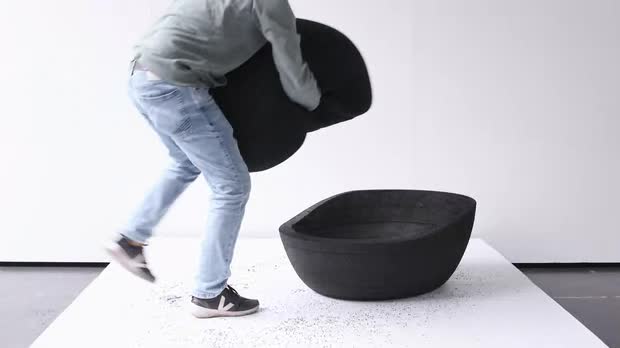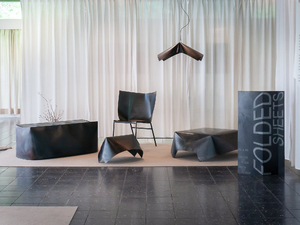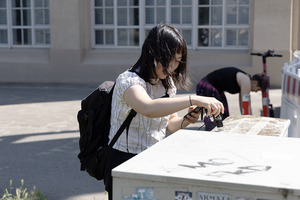Die Kehrseite der Erinnerungskultur
Benachbarte Sets (116)Alle Zusammenhänge anzeigen
Diese Sets wurden den gleichen Sets hinzugefügt wie das ausgewählte Set.
116 Inhalte
- Seite 1 von 10
Emil
- Titel
- Emil
- Titel (en)
- Emil
- Untertitel
- Typografie als Medium historischer Sichtbarkeit
- Untertitel des Projekts/Werks (en)
- A typographic revival reflecting historical erasure
- Autor/in
- Beschreibung (de)
- „Emil” ist ein Diplomprojekt, das die Rolle der Typografie im Umgang mit Erinnerung, Verdrängung und historischen Brüchen untersucht. Im Mittelpunkt stehen die Lebens- und Werkgeschichten jüdischer Gestalter:innen während des Nationalsozialismus, darunter Elizabeth Friedländer und Lucian Bernhard (geb. Emil Kahn).
Ein zentrales Element des Projekts ist das Revival der Bernhard Antiqua von Lucian Bernhard. Die Schrift wurde für die zeitgenössische Nutzung digital neu interpretiert und prägt die gesamte visuelle Ebene des Projekts – von der Plakatserie über die Ausstellungsgestaltung bis hin zur Vortragspräsentation. So wird Typografie zum Untersuchungsgegenstand und zum gestalterischen Werkzeug der Erinnerung.
Für Julian Jaffé, Nachfahre einer jüdischen Familie, die im Nationalsozialismus ins Exil gezwungen wurde, ist "Emil" nicht nur ein typografisches Projekt, sondern auch ein persönlicher Akt des Erinnerns.
- „Emil” ist ein Diplomprojekt, das die Rolle der Typografie im Umgang mit Erinnerung, Verdrängung und historischen Brüchen untersucht. Im Mittelpunkt stehen die Lebens- und Werkgeschichten jüdischer Gestalter:innen während des Nationalsozialismus, darunter Elizabeth Friedländer und Lucian Bernhard (geb. Emil Kahn).
- Beschreibung (en)
- Emil is a diploma project that examines the role of typography in dealing with memory, repression and historical ruptures. It focuses on the lives and works of Jewish designers during National Socialism, including Elizabeth Friedländer and Lucian Bernhard (born Emil Kahn).
A central element of the project is the revival of Bernhard Antiqua by Lucian Bernhard. The font has been digitally reinterpreted for contemporary use and shapes the entire visual level of the project – from the poster series to the exhibition design and lecture presentation. In this way, typography becomes both the subject of investigation and a creative tool of remembrance.
For Julian Jaffé, a descendant of a Jewish family forced into exile during the Nazi era, ‘Emil’ is not only a typographic project, but also a personal act of remembrance.
- Emil is a diploma project that examines the role of typography in dealing with memory, repression and historical ruptures. It focuses on the lives and works of Jewish designers during National Socialism, including Elizabeth Friedländer and Lucian Bernhard (born Emil Kahn).
- Kategorie
- Schlagworte
- Dank an
- Technik/Verfahren/Formate
- Typografie
- Titel
- Emil
- Projektleiter/in
- Semester
- Studiengang
- Typ der Abschlussarbeit
- Importiert am
- 26.06.2025
- Übergeordnete Sets
- 1
- Set enthält
- 0 13
Ephemeral Antipodes
- Titel
- Ephemeral Antipodes
- Titel (en)
- Ephemeral Antipodes
- Autor/in
- Beschreibung (de)
- "Ephemeral Antipodes" ist eine interaktive, Raum einnehmende Klanginstallation. Die Adern der elektronischen Welt, simple Stromkabel, wachsen zu Kupferskulpturen heran. Aufgrund menschlichen Handelns erzeugen analoge Bauteile auf Platinen den Klang und fragile, in Ton gefasste Lautsprecher brechen unter der Last ihrer eigenen Resonanz zusammen. Durch den schmalen Eingang betritt man einen nur spärlich beleuchteten Raum. Seine Wände verschwinden in der Dunkelheit und erzeugen die Illusion einer grenzenlosen Tiefe.
Es lässt sich nur schemenhaft ein metallisch glänzender Wald aus nadelbaumartigen, schwebenden Adern ausmachen. Meterlange, versetzt angebrachte Skulpturen entflochtener Kupferkabel nehmen das komplette erste Drittel des Raumes ein. Die einzelnen Kabeläste hängen so eng nebeneinander, dass beim Versuch hindurchzukommen sich zwangsläufig Kabel berühren. Wegen der Leitfähigkeit des Kupfers wird durch den Kontakt von Ast zu Ast ein Kreislauf geschlossen, ein Schalter aktiviert und ein spezifischer Signalton generiert.
Die Impulsenergie, der Mensch, als Auslöser zur Systemveränderung. Der Klang wirkt dissoziativ, da die Lautsprecher erst nach dem Durchschreiten des Kupferwaldes am anderen Ende des Raumes sichtbar werden. Da jeder Kupferast einzeln und beweglich aufgehängt ist, kann dadurch wie bei einem newtonschen Pendel der Stoß der Bewegung zu einer Kettenreaktion führen und damit ein überraschender Signalton-Noise entstehen. Die Stränge variieren leicht in ihrem Frequenzbereich, wodurch eine Bandbreite an Tönen hörbar gemacht werden kann, wenn man bewusst den kompletten Raum des Kupferdraht-Dickichts mit seinem Hindurchschreiten in Bewegung versetzt. Am anderen Ende des Kupferwaldes türmen sich organisch anmutende Keramik-Gefäße zu einem hohen Berg auf, in denen die Klang wiedergebenden Lautsprecher eingebaut sind. Der Ton wird durch die Wahl der organartigen, in ihren Größen stark abweichenden Keramikhüllen verzerrt wiedergegeben. Teil des Konzeptes ist, dass die naturfarbenen Gehäuse nur einmal gebrannt oder luftgetrocknet werden, um Risse oder ein Zerbrechen durch
Klangvibrationen zu provozieren.
Ein langsamer Zerfall des hohen Klang-Geschwürs. Zwischen Wald und Berg ist die Distanz bewusst gewählt. Es ist dadurch entweder möglich, Klang zu erzeugen oder sich die Gefäße im Detail anzuschauen.
Doch zur vollkommenen Ruhe kommt es beim Ausbleiben der Interaktion mit dem Noise Wald nicht. Grob nach der Zeitspanne eines unscharf werdenden Blicks hin zum Fokus auf den eigenen inneren Monolog, brodelt ein anschwellender tiefer, körperlich spürbarer Basston durch den Raum. Monotonie bei Stillstand, die in ihrer Vorhersehbarkeit des immer gleichen meditativen Tieftons etwas beruhigendes hat. Doch je tiefer die Tonfrequenz, desto stärker wird die Vibration des Lautsprecher-Schalls. Durch die vom Stillstand ausgelöste Bass-Monotonie nimmt das Risiko der Zermürbung des Ton-Geschwürs dramatisch zu.
Die Raum-Atmosphäre ändert sich. Der tiefe Klang wird körperlich spürbar und das Risiko der Zermürbung der Gefäße nimmt deutlich zu.
Die eigene Wahrnehmung an der Grenze zum Kurzschluss. Konsequenzen solcher Entscheidungen führen zu unvorhersehbaren Kettenreaktionen.
Eine überfordernde Echtzeit-Simulation des möglichen Handelns ohne Ergebnis und Ideallösung.
Ursache und Wirkung – gegenseitig provozierende Katalysatoren, die sich von monotoner Routine in unreflektierte Impulsivität steigern.
Die Arbeit ist ein Ort, der einem periphere Emotionen wieder vor Augen führt.
Ein Experiment über Wahrnehmung und Reizbarkeit.
Eine Simulation zwischen Kontrolle und Grenzüberschreitung, die in ihrer Überstimulanz und dem daraus folgenden Kollaps ein mögliches Ende findet.
Performance von Kiesecker-Hoess.
Im Juli 2023 wurde "Ephemeral Antipodes" mit dem Preis der Heinrich-Hertz-Gesellschaft durch die Fördergesellschaft ZKM / HfG e.V. ausgezeichnet.
- https://hfg-karlsruhe.de/archiv/hfg-studierende-du…
- https://www.schroff-stiftungen.de/preistraeger-der…
Shortlist Nominierung “Beste Abschlussarbeit” durch den Fachbereich Medienkunst für die Preise der Fördergesellschaft ZKM / HfG e.V. 2023
- https://hfg-karlsruhe.de/projekte-rundgang-2023/ep…
Großes Studio der Staatlichen Hochschule für Gestaltung Karlsruhe 2023
- https://hfg-karlsruhe.de/archiv/eroeffnung-der-aus…
- "Ephemeral Antipodes" ist eine interaktive, Raum einnehmende Klanginstallation. Die Adern der elektronischen Welt, simple Stromkabel, wachsen zu Kupferskulpturen heran. Aufgrund menschlichen Handelns erzeugen analoge Bauteile auf Platinen den Klang und fragile, in Ton gefasste Lautsprecher brechen unter der Last ihrer eigenen Resonanz zusammen. Durch den schmalen Eingang betritt man einen nur spärlich beleuchteten Raum. Seine Wände verschwinden in der Dunkelheit und erzeugen die Illusion einer grenzenlosen Tiefe.
- Beschreibung (en)
- "Ephemeral Antipodes" is an interactive and space-occupying sound installation. The veins of the electronic world, simple wires grow into copper sculptures. Analog components on circuit boards create the sound and speakers installed inside fragile clay bowls collapse under their own
resonance.
Through the narrow entrance, one enters a sparsely lit room. Its walls disappear into darkness, creating the illusion of endless depth. A shiny metallic forest of needle-like, floating veins can only be dimly distinguished. Staggered, meter-long sculptures of unbraided copper cables
take up the entire first third of the room. The individual cable branches hang so closely to one another that cables inevitably touch when one attempts to pass through them. Because of the copper's conductivity, contact from branch to branch closes a circuit, activates a switch, and generates a specific noise. The impulse energy, the human being, as a trigger to change the system. The sound has a dissociative effect, as the speakers only become visible after passing through the copper forest towards the other end of the room. Since each copper branch is individually and movable suspended, the shock of movement can thereby lead to a chain reaction, as in a Newtonian Pendulum, resulting in a surprising signal sound noise. The strands vary slightly in their frequency spectrum, allowing a range of tones to be made audible by consciously setting the entire space of the copper wire thicket in motion as one passes through.
Near the other end of the copper forest, organic-looking ceramic vessels pile up into a tall mountain, encasing the audio-reproducing loudspeakers. The sound is rendered distorted by the choice of organ-like ceramic skins, which vary significantly in size. Part of the concept is that the natural-colored casings are fired or air-dried only once to provoke cracking or shattering from sonic vibrations.
A slow decay of the tall noise ulcer. The distance between forest and mountain is deliberately chosen. Through this it is either possible to create sound or to look at the vessels in detail.
However, complete silence does not occur in the absence of interaction within the woods. Roughly after the time span of a blurring gaze towards the focus on one's own inner monologue, a swelling deep, physically sense-able bass tone simmers through the air.
Monotony at a standstill, there is something soothing in its predictability of the same meditative deep timbre over and over again. But the lower the frequency, the stronger the vibration gets of the resounding bass wave of the speakers.
Due to the monotony of the bass triggered by standstill, the risk of fracturing the sound tumor increases dramatically.
The mood of the atmosphere in the room changes. The deep sound becomes physically sensible and the risk of wearing down the vessels increases significantly.
One's own perception on the verge of short-circuiting, consequences of such decisions lead to unpredictable chain reactions.
An overwhelming real-time simulation of possible action without any result or an ideal solution.
Cause and effect – mutually provoking catalysts, which increase from monotonous routine into unreflected impulsivity.
"Ephemeral Antipodes" is a place that brings peripheral emotions front of mind again. An experiment on perception and irritability. A simulation between control and transgression, which finds a possible end in its overstimulation and its resulting collapse.
Performance by Kiesecker-Hoess.
Winner of the 2023 Heinrich-Hertz-Gesellschaft Price, honored by Fördergesellschaft ZKM / HfG e.V.
- https://hfg-karlsruhe.de/en/archiv/hfg-studierende…
- https://www.schroff-stiftungen.de/preistraeger-der…
Shortlist Nomination “Best Final Thesis” by the Department of Media Art for the prizes of the Fördergesellschaft ZKM / HfG e.V. 2023
- https://hfg-karlsruhe.de/en/projekte-rundgang-2023…
Großes Studio at Karlsruhe University of Arts and Design 2023
- https://hfg-karlsruhe.de/en/archiv/eroeffnung-der-…
- "Ephemeral Antipodes" is an interactive and space-occupying sound installation. The veins of the electronic world, simple wires grow into copper sculptures. Analog components on circuit boards create the sound and speakers installed inside fragile clay bowls collapse under their own
- Kategorie
- Typ des Projekts/Werks
- Schlagworte
- Datierung
- 02/03/2023
- Material
- Technik/Verfahren/Formate
- Kupfer, Platinen, Ton, Multi-Kanal Sound - Interaktive Klanginstallation, Kupferbaum (170 x 90 cm): aus 6m FLY B Kabel; 63 Stück, Kupferdraht, PVC Verkleidung Aufhängung (3 m): aus 6m FLY B Kabel Ummantelung; 63 Stück, Kabelbinder, PVC Verkleidung Verbindung Strom (verschiedene Längen): abgeschirmtes Kabel; 32 Stück, ca. 400 m Gesamtlänge Verbindung Erdung (ca 9 m): einfaches Kabel; 32 Stück, 290 m Gesamtlänge Sensorik Schalter und Klangerzeugung (40 x 65 cm): Platinen auf Acryl; 16 Stück, Leiterplatten, Bauteile Sensorik Drohne: Max Patch und Bewegungsmelder; Computer, Sensor, Verbindungskabel Ton-Lautsprecher (verschiedene Größen): Tongefäß und Lautsprechertreiber; Ca 95 Stück, ca 320kg Gesamtgewicht Weitere Technik: 6 x E8 Lautsprecher, 4 x 8-Kanal Verstärker, 2 x DI-Box, Mischpult, 10er Multicore XRL, diverse XLR-,Mehrfach- und Stromkabel Konstruktion Aufhängung Kupferbäume: Stangenkräne, Alu-Pipes, Doppelschellen, Traversen
- Abmessungen
- Bereich Bäume (63 Stück): 9m x 7m x 3,7m/ Bereich Ton-Berg (ca 95 Stück): 5m x 4m x 2m
- Ort
- Großes Studio, HfG Karlsruhe
- Stadt
- Land
- Internetlinks
- Titel
- Ephemeral Antipodes
- Projektleiter/in
- Semester
- Studiengang
- Typ der Abschlussarbeit
- Importiert am
- 03.12.2024
- Übergeordnete Sets
- 2
- Set enthält
- 0 28
ERLEBNIS THEATER
- Titel
- ERLEBNIS THEATER
- Untertitel
- Für eine wahrnehmungszentrierte Raumtheorie im Theater
- Untertitel des Projekts/Werks (en)
- For a perception-centered theory of space in the theater
- Autor/in
- Beschreibung (de)
- Das Projekt behandelt die sensitive Wahrnehmung in Räumen und kritisiert dessen Nicht-Vorhandensein speziell in Theater-Architekturen.
- Beschreibung (en)
- The project deals with sensitive perception in spaces and criticizes its non-existence, especially in theater architecture.
- Kategorie
- Schlagworte
- Datierung
- Mai 2021
- Mitwirkende
- Ort: Institution
- Ort
- Großes Studio
- Stadt
- Land
- Internetlinks
- Titel
- ERLEBNIS THEATER
- Projektleiter/in
- Semester
- Studiengang
- Typ der Abschlussarbeit
- Importiert am
- 14.06.2024
- Übergeordnete Sets
- 1
- Set enthält
- 0 11
eternal girlhood
- Titel
- eternal girlhood
- Untertitel
- oh my dreams
- Autor/in
- Beschreibung (de)
- “eternal girlhood” ist eine konzeptionelle Arbeit, welche aus einer Rauminstallation und einer Publikation besteht.
Ursprünglich in den Chinesischen Pavillons des Fasanengartens in Karlsruhe installiert, wurde der Raum mit der Handlung der Publikation durch Requisiten sowie ein selbst produziertes Musikstück verknüpft.
Das Projekt ermöglicht eine Reise in eine poetische Geschichte, inspiriert von persönlichen und kulturellen Themen wie Girlhood, Coming-of-Age und Growing Pains.
Die handgebundene Publikation mit glitzerndem und geprägtem Umschlag umfasst auf ca. 100 Seiten neben Serien analoger Schwarzweiß-Fotografie farbige Mittelformat-Fotos, begleitet von analogen Schnappschüssen und Illustrationen im Riso-Druck.
Zwischen Fotoserien und Illustrationen sind Songtexte sowie Skriptfragmente und Gedichte eingestreut, in Referenz zu Filmsequenzen aus Coming-of-Age-Geschichten. Es ergibt sich die zeitlose Skizze eines Mädchens, das Teil einer innig verbundenen Mädchengruppe ist.
Transparente Drucke von drei Mittelformat-Fotografien werden vom Fensterlicht erleuchtet und symbolisieren in Zusammenhang mit dem Buch unterschiedliche Kapitel der Geschichte.
Unter einem Baldachin, umgeben von funkelnd tanzenden Schmetterlingen, können Besucher*innen in diese Welt eintauchen und sind eingeladen, für einen Moment Teil von „eternal girlhood“ zu sein, fernab der Echtzeit.
- “eternal girlhood” ist eine konzeptionelle Arbeit, welche aus einer Rauminstallation und einer Publikation besteht.
- Beschreibung (en)
- “eternal girlhood“ is a conceptional artwork, blending a publication with its installation space.
Initially installed in the Chinese pavillons of the Fasanengarten in Karlsruhe, the space was connected to the story of the book through props and a musical sound score.
The project offers a journey into a poetic story, inspired by personal and cultural ideas on girlhood, coming of age and growing pains.
Handbound, wrapped in a glittery embossed dustcover, the publication features around 100 pages with multiple series of black and white film photography, medium format shots underlined by analog snapshots and Riso printed Illustrations. In between the chapters of photography and Illustrations, lyrics, fragments of script and poems are inserted in reference to movie sequences from coming of age stories. A timeless profile of a girl being part of girlhood and a deeply connected friendship is created.
Transparent prints of three medium format photos are illuminated by the windows’ natural light and symbolize different chapters of the story in combination with the book.
Underneath a canopy, surrounded by sparkling dancing butterflies, visitors can dive into this world and are invited to become part of “eternal girlhood“, away from modern reality.
- “eternal girlhood“ is a conceptional artwork, blending a publication with its installation space.
- Kategorie
- Typ des Projekts/Werks
- Schlagworte
- Datierung
- 05.07.2024
- Mitwirkende
- Dank an
- Sprache
- Material
- Technik/Verfahren/Formate
- Risographie, Digitaldruck, Mediumformat-Fotografie, Schreibmaschine, Laser, Prägung
- Abmessungen
- Fläche: ca. 5m x 5m, Höhe der Aufhängung ca. 3m
- Ort: Institution
- Ort
- Chinesische Pavilions des Fasanengarten
- Stadt
- Land
- Beteiligte Institution(en)
- Titel
- eternal girlhood
- Projektleiter/in
- Semester
- Studiengang
- Typ der Abschlussarbeit
- Importiert am
- 05.11.2024
- Übergeordnete Sets
- 2
- Set enthält
- 0 21
Etwas Aufnehmen
- Titel
- Etwas Aufnehmen
- Titel (en)
- Get in touch with
- Untertitel
- Eine Reading Performance in 4 Teilen
- Untertitel des Projekts/Werks (en)
- A reading performance in 4 chapters
- Autor/in
- Beschreibung (de)
- "Etwas Aufnehmen" ist eine 30-minütige interaktive Reading Performance über den (Tast-) Sinn. Sie findet an einem 15 m langen Steintisch statt, 80 kg kinetischer Sand liegen auf ihm verteilt. Die Performance entstand in sechsmonatiger Recherche und im Austausch mit einer blinden Künstlerin, einem Tastforscher, einem Übersetzer von visuellen Lernmaterialien und einer Tierkommunikationsexpertin und erzählt außerdem von einer Kollaboration mit einem Hund (Betty). Welchen Stellenwert nimmt der Tastsinn in unserer Wahrnehmung ein, um Dinge wortwörtlich zu "begreifen"? Wie kommuniziere oder gestalte ich mit einem Tier, welches auf ganz andere Sinne zurückgreifen kann? "Etwas Aufnehmen" hinterfragt die eigene Wahrnehmung und beschreibt den Drang nach Verständigung. Die Reading Performance ist sowohl taktil, auditiv als auch visuell wahrnehmbar.
- Beschreibung (en)
- "Get in touch with" is a 30-minute interactive reading performance about the (tactile) sense. It takes place on a 15 metre long stone table with 80 kg of kinetic sand on top. The performance is the result of a six-month research and exchange with a blind artist, a tactile researcher, a translator of visual learning materials and an animal communication expert, and also tells of a collaboration with a dog (Betty). What role does the sense of touch play in our perception? How do I communicate or design with an animal that has access to completely different senses? "Etwas Aufnehmen" questions our own perception and describes the urge for understanding. The reading performance can be experienced tactilely, acoustically and visually.
- Kategorie
- Typ des Projekts/Werks
- Schlagworte
- Datierung
- Februar 2023
- Mitwirkende
- Dank an
- Sprache
- Untertitel (Film)
- Material
- Abmessungen
- Länge: 15m, Breite: 25cm, Höhe: 25cm
- Dauer
- 30min
- Ort: Institution
- Ort
- Großes Studio
- Stadt
- Land
- Internetlinks
- Titel
- Etwas Aufnehmen
- Projektleiter/in
- Semester
- Studiengang
- Typ der Abschlussarbeit
- Importiert am
- 05.10.2024
- Übergeordnete Sets
- 1
- Set enthält
- 0 16
Excreta Fluxorum - Theatrum Instrumentorum
- Titel
- Excreta Fluxorum - Theatrum Instrumentorum
- Untertitel
- George Maciunas und die Kultur der „curiositas”
- Autor/in
- Beschreibung (de)
- „Möglicherweise erscheinen die intermediären Kunstformen der 60er-jahre als zu komplex, ihre Manifestationen zu sehr als Teil einer noch lebenden Kunstgeschichte, vielleicht hindert auch die noch nicht abgeschlossene Bewältigung der postmodernen Wende in Philosophie, Kunst und Literatur an einer generalüberholten wissenschaftlichen Annäherung an diesen Themenbereich, der sich von der fließenden, aus Künstlerkommentaren über Kritiken in methodischen Darstellungen hervorgegangenen bisherigen Versuchen einer vorläufigen Einordnung des Phänomens Fluxus abzugrenzen hätte."
- Beschreibung (en)
- “It is possible that the intermediary art forms of the 1960s appear too complex, their manifestations too much a part of a still living art history; perhaps the fact that the postmodern turn in philosophy, art and literature has not yet been completed also prevents a generally overhauled academic approach to this subject area, which would have to distinguish itself from the fluid attempts at a provisional classification of the phenomenon of Fluxus that have emerged from artists' commentaries on critiques in methodical presentations.”
- Kategorie
- Typ des Projekts/Werks
- Schlagworte
- Datierung
- 04.03.1999
- Sprache
- Ort: Institution
- Stadt
- Land
- Titel
- Excreta Fluxorum - Theatrum Instrumentorum
- Projektleiter/in
- Semester
- Studiengang
- Typ der Abschlussarbeit
- Archiv-Signatur
- HfG HS 1999 01
- Externes Archiv
- Importiert am
- 11.01.2024
- Übergeordnete Sets
- 1
- Set enthält
- 0 3
existence.exe
- Titel
- existence.exe
- Titel (en)
- existence.exe
- Autor/in
- Beschreibung (de)
- Das Konzept der „Selbstoptimierung“ hat eine zunehmende gesellschaftliche Relevanz erreicht, dementsprechend haben zahlreiche Apps, die sich auf den Körper, die Emotionen und das Selbstmanagement konzentrieren, nach und nach mein Leben durchdrungen.
Ich scheine gleichzeitig in zwei Formen zu existieren: einerseits als organisches Wesen, das aus Wahrnehmung, Widersprüchen und zufälligen Erfahrungen besteht; andererseits als digitales Modell, das von verschiedenen Anwendungen konstruiert wurde.
Allmählich gewöhnte ich mich daran, mich selbst über Zahlen zu messen und zu analysieren – von der Kalorienaufnahme über Schlafzyklen bis hin zu feinen Schwankungen der Herzfrequenz – doch dabei verlor ich zunehmend das Vertrauen in die natürliche Wahrnehmung meines Körpers.
Diese Programme geben vor, „personalisierte Dienste“ zu sein, verwandeln uns letztlich aber in ein einheitliches Datenformat, das sich bequem kategorisieren, vergleichen und extrahieren lässt.
Je mehr Daten es über mich gibt, desto weniger scheine ich mich selbst zu spüren.
- Das Konzept der „Selbstoptimierung“ hat eine zunehmende gesellschaftliche Relevanz erreicht, dementsprechend haben zahlreiche Apps, die sich auf den Körper, die Emotionen und das Selbstmanagement konzentrieren, nach und nach mein Leben durchdrungen.
- Beschreibung (en)
- As “self-optimization” has become a widely accepted life concept, a large number of apps focusing on the body, emotions, and self-management have gradually infiltrated my life.
I seem to exist in two forms at the same time: one, an organic being composed of perception, contradictions, and incidental experiences; the other, a digital model constructed by various applications.
I gradually got used to measuring and examining myself through numbers—from calorie intake to sleep cycles and subtle fluctuations in heart rate—but in doing so, I slowly lost trust in my body’s natural perception.
These programs present themselves as “personalized services,” yet ultimately convert us into a single data format, convenient for categorization, comparison, and extraction.
The more data there is about me, the less I seem to feel myself.
- As “self-optimization” has become a widely accepted life concept, a large number of apps focusing on the body, emotions, and self-management have gradually infiltrated my life.
- Kategorie
- Typ des Projekts/Werks
- Schlagworte
- Datierung
- 14.05.2025
- Mitwirkende
- Dank an
- Dauer
- 2 Tage
- Ort: Institution
- Ort
- Lichthof 4
- Stadt
- Land
- Titel
- existence.exe
- Projektleiter/in
- Semester
- Studiengang
- Typ der Abschlussarbeit
- Importiert am
- 19.05.2025
- Übergeordnete Sets
- 1
- Set enthält
- 0 26
Fernand Léger und Ballet Mécanique
- Titel
- Fernand Léger und Ballet Mécanique
- Untertitel
- Film als Kunst, Filmkunst, Film und Kunst
- Autor/in
- Beschreibung (de)
- „‚Ballet Mécanique‘ ist zu einer Zeit entstanden, die als Höhepunkt, und immer wieder auch als Wendepunkt in Légers Malerei verstanden wird. Der Film fügt sich nicht nur in seine künstlerische Konzeption ein, sondern hat diese auch zum Thema. ‚Ballet Mécanique‘ ist ein Manifest, nicht nur für seine Kunst, sondern auch für das Kino. Wie bei seinen Literatenfreunden ist Légers intensive Auseinandersetzung mit dem Kino von einer doppelten Intention geprägt, von deren Hinwendung zu dem jungen Medium als potentiellen Mittel, die eigene Kunst zu reformieren, und vom Entwurf eines neuen Konzepts von Film, der seinerseits durch die gestalterische Intervention von Dichtern und Malern zu seinen eigenen Ausdrucksmitteln findet."
- Beschreibung (en)
- “'Ballet Mécanique' was created at a time that is seen as a high point, and also repeatedly as a turning point, in Léger's painting. The film not only fits into his artistic conception, but also has it as its theme. 'Ballet Mécanique' is a manifesto, not only for his art, but also for cinema. As with his literary friends, Léger's intensive engagement with cinema is characterized by a double intention, by their turn to the young medium as a potential means of reforming their own art, and by the design of a new concept of film, which in turn finds its own means of expression through the creative intervention of poets and painters.”
- Kategorie
- Schlagworte
- Datierung
- Juli 1997
- Sprache
- Ort: Institution
- Stadt
- Land
- Titel
- Fernand Léger und Ballet Mécanique
- Projektleiter/in
- Semester
- Studiengang
- Typ der Abschlussarbeit
- Archiv-Signatur
- HfG HS 1997 02
- Externes Archiv
- Importiert am
- 11.01.2024
- Übergeordnete Sets
- 1
- Set enthält
- 0 2
finding traces and placing connections
- Titel
- finding traces and placing connections
- Autor/in
- Beschreibung (de)
- „finding traces and placing connections“ ist eine interaktive Kunstinstallation und ein persönlicher Liebesbrief an das Material Kupfer. Die Arbeit zelebriert die Funktionalität, Vielseitigkeit und Schönheit des Kupfers.
Besucher*innen können die in den Teppich eingelassenen Kupferflächen durch fünf verkupferte Steine verbinden und kontrollieren dadurch Klang und Licht des Raumes.
Die Komposition für das Werk wurde aus Aufnahmen, die durch Interaktion mit Kupferobjekten entstanden sind, generiert.
Jede aktivierte Fläche leuchtet auf und fügt eine Audiospur zur Komposition hinzu.
Dadurch entsteht nicht nur eine Interaktion mit der Arbeit, sondern auch eine Interaktion zwischen den Besucher*innen. Durch das Zusammenspiel entstehen individuelle Kompositionen und Kombinationen der Audiospuren und immer neue Abwandlungen des Klanges.
„finding traces and placing connections“ lädt ein, zu entdecken, zu hören.
- „finding traces and placing connections“ ist eine interaktive Kunstinstallation und ein persönlicher Liebesbrief an das Material Kupfer. Die Arbeit zelebriert die Funktionalität, Vielseitigkeit und Schönheit des Kupfers.
- Beschreibung (en)
- “finding traces and placing connections” is an interactive art installation and a personal love letter to the material copper. The work celebrates the functionality, versatility and beauty of copper.
Visitors can connect the copper surfaces embedded in the carpet with five copper-plated stones and thereby control the sound and light of the room.
The composition for the work was generated from recordings made through interaction with copper objects.
Each activated surface lights up and adds an audio track to the composition.
This not only creates an interaction with the work, but also an interaction between the visitors. The interplay creates individual compositions and combinations of audio tracks and ever new variations of the sound.
“finding traces and placing connections” invites you to discover and listen.
- “finding traces and placing connections” is an interactive art installation and a personal love letter to the material copper. The work celebrates the functionality, versatility and beauty of copper.
- Kategorie
- Typ des Projekts/Werks
- Schlagworte
- Datierung
- Juni 2024
- Mitwirkende
- Dank an
- Material
- Abmessungen
- 4m x 5m
- Ort: Institution
- Titel
- finding traces and placing connections
- Projektleiter/in
- Semester
- Studiengang
- Typ der Abschlussarbeit
- Importiert am
- 05.11.2024
- Übergeordnete Sets
- 2
- Set enthält
- 0 23
Float
- Titel
- Float
- Titel (en)
- Float
- Autor/in
- Beschreibung (de)
- Der Float Lounger, entworfen von Felix Reif und Finn de Bruyn, hebt den Sitzsack auf das Niveau eines vollwertigen Relaxmöbels.
Sowohl die Basis als auch das Kissen bestehen aus expandiertem Polypropylen. Der Einsatz dieses innovativen Materials, das in der Möbelproduktion nur selten verwendet wird, ermöglicht einen leichten, robusten und zu 100 % recycelbaren Sitz. Das mit expandierten Polypropylen-Perlen gefüllte Kissen passt sich jeder Körperform an, steigert die Entspannung und vermittelt dabei das Gefühl, an einem Sonntagabend in einem Schaumbad zu versinken.
- Der Float Lounger, entworfen von Felix Reif und Finn de Bruyn, hebt den Sitzsack auf das Niveau eines vollwertigen Relaxmöbels.
- Beschreibung (en)
- The Float lounger, designed by Felix Reif and Finn de Bruyn, elevates the bean bag to the level of a full-fledged piece of relaxation furniture.
The base and cushion are made of expanded polypropylene. The use of this innovative material, which is rarely found in furniture production, allows for a lightweight, resilient, and 100% recyclable seat. The cushion, filled with expanded polypropylene beads, adapts to every body shape enhancing relaxation while creating the sensation of sinking into a bubble bath on a Sunday evening.
- The Float lounger, designed by Felix Reif and Finn de Bruyn, elevates the bean bag to the level of a full-fledged piece of relaxation furniture.
- Kategorie
- Typ des Projekts/Werks
- Datierung
- 02.2025
- Mitwirkende
- Dank an
- Material
- Titel
- Float
- Importiert am
- 21.07.2025
- Übergeordnete Sets
- 0
- Set enthält
- 0 7
Folded Sheets
- Titel
- Folded Sheets
- Autor/in
- Beschreibung (de)
- Folded Sheets untersucht, wie sich Papier-Falttechniken auf Stahlbleche übertragen lassen. Rechteckige Tafeln werden durch gezielte Einschnitte und Faltungen in stabile dreidimensionale Formen gebracht, ohne dass Material verloren geht. Der Prozess des Schwarzbrennens, bei dem Leinöl in die Oberfläche eingebrannt wird, verleiht den Objekten ihre charakteristische schwarze Färbung, schützt sie vor Korrosion und unterstützt die strukturelle Festigkeit.
- Beschreibung (en)
- Folded Sheets explores the possiblities of transferring paper folds into steel sheet furniture. By using cuts and folds on rectangular steel sheets, tensioned ridgid shapes without offcuts are created. The objects are further strenghened by blackening the surface with burnt linseed oil.
- Kategorie
- Typ des Projekts/Werks
- Schlagworte
- Datierung
- 2025
- Dank an
- Material
- Technik/Verfahren/Formate
- Folding, Blackening with Linseed Oil.
- Stadt
- Land
- Internetlinks
- Titel
- Folded Sheets
- Projektleiter/in
- Studiengang
- Typ der Abschlussarbeit
- Importiert am
- 15.07.2025
- Übergeordnete Sets
- 0
- Set enthält
- 0 22
FROM ENLIGHTENMENT TO ENLICHENMENT
- Titel
- FROM ENLIGHTENMENT TO ENLICHENMENT
- Titel (en)
- FROM ENLIGHTENMENT TO ENLICHENMENT
- Untertitel
- Flechten, Symbiose und posthumanistische Perspektiven in Kunst und Theorie
- Untertitel des Projekts/Werks (en)
- Lichens, symbiosis and posthumanist perspectives in art and theory
- Autor/in
- Beschreibung (de)
- Die Aufklärung („Enlightenment“) stellte den Menschen ins Zentrum des Denkens – doch Flechten („Lichen“) lehren uns eine andere Art der Weltwahrnehmung: relational, vernetzt, nicht-menschlich-zentriert. Als symbiotische Verbindungen von Pilzen und Algen oder Cyanobakterien verkörpern sie ein Denken jenseits des Individuellen: Sie sind mehr-als-menschliche Organismen, Holobionten, Netzwerke aus Kooperation und Anpassung. Sie gedeihen in extremen Umgebungen, überdauern Jahrhunderte und bilden fragile Ökologien,
die oft übersehen werden – und doch fundamentale Lektionen für unser eigenes Dasein bereithalten. Dieses transdisziplinäre Seminar bewegt sich zwischen Wissenschaft, Philosophie und Medienkunst. Eine Exkursion mit Lichenolog*innen macht uns mit der stillen, aber
hochkomplexen Existenz der Flechten vertraut. Meditative Audiowalks laden dazu ein, das Netzwerk dieser Lebensformen zu dokumentieren und sich mit ihrer Zeitlichkeit und Materialität zu verbinden. Durch das Lesen zentraler Texte von Lynn Margulis, Scott Gilbert, Donna Haraway und Anna Tsing hinterfragen wir Konzepte von Autonomie, Subjektivität und multispeziesalem Zusammenleben. Schließlich werden wir in einem Workshop das gesammelte Wissen in Medienkunstwerke überführen – als spekulative Antworten auf die ökologischen und philosophischen Herausforderungen unserer Zeit.
- Die Aufklärung („Enlightenment“) stellte den Menschen ins Zentrum des Denkens – doch Flechten („Lichen“) lehren uns eine andere Art der Weltwahrnehmung: relational, vernetzt, nicht-menschlich-zentriert. Als symbiotische Verbindungen von Pilzen und Algen oder Cyanobakterien verkörpern sie ein Denken jenseits des Individuellen: Sie sind mehr-als-menschliche Organismen, Holobionten, Netzwerke aus Kooperation und Anpassung. Sie gedeihen in extremen Umgebungen, überdauern Jahrhunderte und bilden fragile Ökologien,
- Beschreibung (en)
- The Enlightenment placed humans at the centre of thought – but
lichens teach us a different way of perceiving the world: relational, interconnected,
non-human-centred. As symbiotic combinations of fungi and algae or cyanobacteria, they embody a way of thinking beyond the individual: they are more-than-human organisms, holobionts, networks of cooperation and adaptation. They
thrive in extreme environments, survive for centuries and form fragile ecologies
that are often overlooked – yet hold fundamental lessons for our own existence
.
This transdisciplinary seminar moves between science, philosophy and
media art. An excursion with lichenologists familiarises us with the quiet but
highly complex existence of lichens. Meditative audio walks invite us to document the
network of these life forms and connect with their temporality and
materiality. By reading key texts by Lynn Margulis, Scott Gilbert,
Donna Haraway and Anna Tsing, we question concepts of autonomy, subjectivity and
multispecies coexistence. Finally, in a workshop, we will transform the
knowledge we have gathered into media artworks – as speculative responses to the
ecological and philosophical challenges of our time.
- The Enlightenment placed humans at the centre of thought – but
- Kategorie
- Typ des Projekts/Werks
- Schlagworte
- Datierung
- Juni 2025
- Mitwirkende
- Dank an
- Sprache
- Ort: Institution
- Ort
- Bio Design Lab
- Stadt
- Land
- Titel
- FROM ENLIGHTENMENT TO ENLICHENMENT
- Importiert am
- 17.07.2025
- Übergeordnete Sets
- 0
- Set enthält
- 0 21
